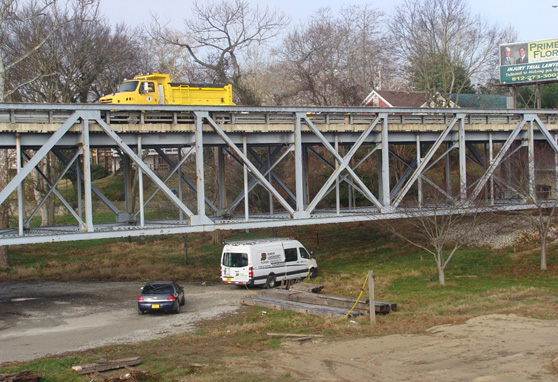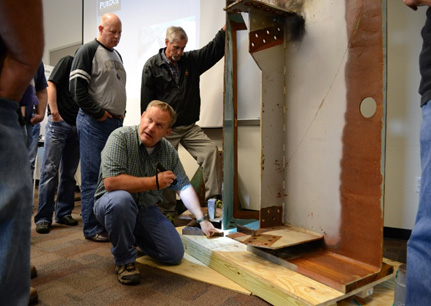Design of Steel Bridges for Fatigue & Fracture
Course brochure: Design of Steel Bridges for Fatigue & Fracture (PDF)

This two-day course will focus on fatigue and fracture from the point of view of individuals performing fatigue analysis for the design of new bridges and evaluation and retrofit of existing bridges. Guidance on when and why to select a specific type of non-destructive testing (NDT) will also be discussed. Effective and ineffective retrofit strategies for steel bridges will also be presented. Topics include history of the development of the current AASHTO fatigue provisions, cycle counting and stress-range concepts, loading for design vs. evaluation, detail classification, constraint-induced fracture (CIF), history of the AASHTO/AWS Fracture Control Plan (FCP), fatigue damage calculation, repair and retrofit, and an introduction to NDT. The course will utilize several cases studies for illustrative purposes.
Meet the Instructors

Robert Connor, PhD, is an associate professor of civil engineering at Purdue University and Director of the Steel Bridge Research, Inspection, Training, and Engineering (S-BRITE) Center. Dr. Connor is nationally recognized as an expert in fatigue and fracture of steel bridges and sign structures.

Mark Bowman, PhD, PE, is a professor of civil engineering at Purdue University and Director of the Robert L. and Terry L. Bowen Laboratory for Large Scale Civil Engineering Research. Dr. Bowman has over 30 years of experience in bridge design and analysis.

Jason B. Lloyd, PhD, PE, is the Bridge Steel Specialist, West Market, for the National Steel Bridge Alliance. Dr. Lloyd has performed numerous field instrumentation, laboratory, and fitness-for-service studies on various steel bridge types. He specializes in full-scale testing, field monitoring, fatigue evaluation, fracture, and repair and retrofit of steel bridges
Learning Objectives
• Demonstration of the principles of the design of steel structures for fatigue and fracture
• Understanding of the role of residual stresses and member flaws contributing to fatigue and fracture failure
• Working knowledge of methods used for cycle counting and concepts related to the stress range
• A gathering of the progression of the AASHTO fatigue provisions from the 1960’s to the present day
• Understanding of the AAHSTO load model for fatigue design
• Ability to work through examples of fatigue design for primary stresses, or load-induced fatigue
• Introduction and conception of the AASHTO fatigue details—how to recognize the different details and what their constant amplitude fatigue thresholds are
• Introduction into basic fracture mechanics
• Understanding of the different special cases related to fatigue and fracture in steel bridges and structures
• Working knowledge of structural fatigue analysis
• Ability to recognize fatigue due to secondary stresses, or distortion-induced fatigue
• Exposure to current cutting edge research that is changing the way the industry perceives and designs for fatigue and fracture of steel bridges
Participants will receive hands-on experience with fatigued and fractured sections taken from service providing for a unique look into the fatigue & fracture design of steel bridges.

Agenda for course held at S-BRITE Center (Purdue)
|
Day 1 9:00 - Introduction and Welcome 9:05 - What is Fatigue? What is Fracture? 9:35 – Influences of residual stresses and flaws 10:05 – Cycle counting and stress range concepts 10:45 - Break 11:00 – Response of bridges to truck loads 11:45 – Lunch Break 12:45 - History of AASHTO fatigue provision 1:30 – AASHTO load model for fatigue design 2:10 – Fatigue Design for Primary Stresses 2:45 - Break 3:00 – Introduction to AASHTO fatigue details 3:30 – Detail classification with examples, part A 4:10 - Detail classification with examples, part B 4:50 – Review and open discussion 5:00 – Adjourn, end of Day 1 |
Day 2 9:00 – Fatigue design for primary stress, Ex. 1 9:20 – Hand-on inspection of damaged details 11:20 - Review of hands-on exercise 11:40 – Lunch Break 12:40 – Intro to basic fracture mechanics 1:30 – Special cases: tack welds, etc. 2:00 – Special cases: fracture 2:45 – Break 3:00 –Fatigue evaluation of existing bridges 3:45 – Fatigue due to secondary stresses 4:30 – Review and Adjourn, end of Day 2 |
Day 3 9:00 – Fatigue evaluation, Ex. 2 9:00 – Basic fatigue retrofitting 10:30 – Review and open discussion 10:40 – Open book exam 11:40 – Course adjourned, end of Day 3 |
Agenda for course held off-campus at your facility
|
Day 1 8:30 - Introduction and Welcome 8:35 – What is Fatigue? What is Fracture? 9:05 – Influences of residual stresses and flaws 9:35 – Cycle counting and stress range concepts 10:15 - Break 10:30 – Response of bridges to wheel and truck loads 11:15 – Review of historical progression of AASHTO fatigue provisions 12:00 - Lunch Break 1:00 – AASHTO load model for fatigue design 1:40 – Fatigue Design for Primary Stresses 2:15 - Break 2:30 – Introduction to AASHTO fatigue details 3:00 – Detail classification with examples, part A 3:40 - Detail classification with examples, part B 4:20 – Review and open discussion 4:30 – Adjourn, end of Day 1 |
Day 2 8:30 – Fatigue design for primary stresses, Ex. 1 9:15 – Intro to basic fracture mechanics, Part 1 9:40 – Break 9:55 - Special situations, Tack welds, etc. 10:30 – Special situations, Fracture case studies 11:15 – Fatigue evaluation of existing bridges 12:00 - Lunch Break 1:00 – Fatigue due to secondary stresses 1:45 – Fatigue evaluation, Ex. 2 2:15 - Break 2:30 – Basic fatigue retrofitting 3:15 – Update on current research 3:30 – Open book exam 4:30 – Course adjourned, end of Day 2 |
